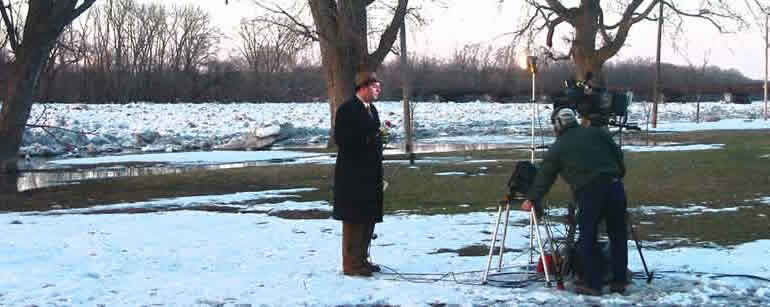
ICE JAMS AND FLOODING
Union College
| HOME |
| General Info |
| Flood History |
| Jams and Dams |
| Schoharie River |
| Collins Pond |
| Media Matters |
Media Matters |
Flooding occurs on the Mohawk River almost every year. Major floods have been of two types: those related to breakup in the spring (or mid-winter), and those related to tremendous rainfall, usually associated with a tropical depression or hurricane. There are several things to keep an eye on when flooding starts. Perhaps the most important is the discharge (Q), which is the amount of water moving through the river channel at any one time. This is typically given in cubic feet per second (CFS), and the United States Geological Survey maintains a number of sites where this parameter is measured. For Schenectady and downstream, the Cohoes Gage is the main source of data for discharge. Another important aspect is Stage Elevation, which is the elevation or height of the water level. Naturally, this is a parameter that is important if you are worried about homes and businesses flooding. In most rivers stage elevation is directly linked to discharge: more water tends to be deeper. However, we’ve found that when Ice is involved in the flooding, jams can back up water making the Stage elevation artificially higher, regardless of discharge. During winter breakup, ice cover on the river breaks up, and moves downstream as ice floes. These ice floes (pronounced “flows”), jostle about as they move downstream, and sometimes they get stuck in constrictions or bends in the river. Ice Jams form at such constrictions, and this means that the ice floe is not moving, but the flood water is freely flowing under the ice. This situation can be extremely dangerous because the ice chunks look solid, but they are not. Occasionally, these ice jams will buckle up and fold on themselves and actually dam the river. This is inherently an unstable situation, and these eventually break up. However, some of the most serious flooding on the Mohawk occurs when Ice Dams form. Water behind the blocked flow can rise rapidly, and in the most dramatic example it rose 25 feet in hours. In 2007 an ice dam formed and blocked the water. Water levels behind the dam rose 15 feet over the early evening. So, when floes start to move, they invariably encounter constrictions. When the floes stop, or jam, Emergency Management personnel monitor the situation very closely because if a dam forms, they will initiate a series of procedures, which might include local evacuation. This happened in the March 2007 event where the Stockade section of Schenectady was evacuated. As the water builds, it tends to naturally destroy the ice dam because ice floats. So, enough build up will likely cause the dam to float and get flushed through the system. When this happens, there is a large volume increase downstream, but these tend to be less serious than the upstream buildup. Note that significant ice floes can jam many times. Some of the recent floes that hove moved through Schenectady have been over 10 miles long. During an event, you are welcome to contact: John Garver, PhD |
This document can be located from http://minerva.union.edu/garverj/mohawk/
© Environmental Science and Policy Program, Union College, Schenectady N.Y. 12308-3107. All rights reserved. No part of the document can be copied and/or redistributed, electronically or otherwise, without written permission from the Director of the Environmental Studies Program, Union College, Schenectady NY, 12308-2311, USA.
|
||